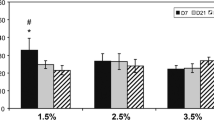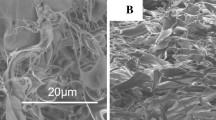Abstract
Introduction
Thermoreversible hydrogels have potential in spine research as they provide easy injectability and mild gelling mechanism (by physical cross-link). The purpose of this study was to assess the potential of thermoreversible hyaluronan-based hydrogels (HA-pNIPAM) (pNIPAM Mn = 10, 20, 35 × 103 g mol−1) as nucleus pulposus cells (NPC) carrier.
Materials and methods
Cytocompatibility (WST-1 assay), viability (trypan blue), morphology (toluidine blue), sulphated glycosaminoglycan synthesis (DMMB assay) and gene expression profile (real-time PCR) of bovine NPC cultured in HA-pNIPAM were followed for 1 week and compared to alginate gel bead cultures. The injectability and cell survival in a whole disc organ culture model were assessed up to day 7.
Results
All HA, HA-pNIPAM and their degradation products were cytocompatible to NPC. HA-pNIPAM hydrogels with no volume change upon gelling maintained NPC viability and characteristic rounded morphology. Glycosaminoglycan synthesis was similar in HA-pNIPAM and alginate gels. Following NPC expansion, both gels induced re-differentiation toward the NPC phenotype. Significant differences between the two gels were found for COLI, COLII, HAS1, HAS2 and ADAMTS4 but not for MMPs and TIMPs. Higher expression of hyaluronan synthases (HAS1, HAS2) and lower expression of COLI and COLII mRNA were noted in cells cultured in HA-pNIPAM (pNIPAM = 20 × 103g mol−1). NPC suspension in HA-pNIPAM was injectable through a 22-G needle without loss of cell viability. Ex vivo, NPC viability was maintained in HA-pNIPAM for 1 week.
Conclusion
A HA-pNIPAM composition suitable for nucleus pulposus repair that provides an injectable carrier for NPC, maintains their phenotype and promotes extracellular matrix generation was identified.









Similar content being viewed by others
References
Schizas C, Kulik G, Kosmopoulos V (2010) Disc degeneration: current surgical options. Eur Cell Mater 20:306–315
Grad S, Alini M, Eglin D, Sakai D, Mochida J, Mahor S et al (2010) Cells and biomaterials for intervertebral disc regeneration. In: Athanasiou KA (ed) Synthesis lectures on tissue engineering, vol 2. Morgan & Claypool, San Rafael, pp 1–104
Masuda K (2008) Biological repair of the degenerated intervertebral disc by the injection of growth factors. Eur Spine J 17(Suppl 4):441–451
Masuda K, Lotz JC (2010) New challenges for intervertebral disc treatment using regenerative medicine. Tissue Eng Part B Rev 16:147–158
Nishida K, Suzuki T, Kakutani K, Yurube T, Maeno K, Kurosaka M et al (2008) Gene therapy approach for disc degeneration and associated spinal disorders. Eur Spine J 17(Suppl 4):459–466
Drury JL, Mooney DJ (2003) Hydrogels for tissue engineering: scaffold design variables and applications. Biomaterials 24:4337–4351
Sakai D (2008) Future perspectives of cell-based therapy for intervertebral disc disease. Eur Spine J 17(Suppl 4):452–458
Watanabe T, Sakai D, Yamamoto Y, Iwashina T, Serigano K, Tamura F et al (2010) Human nucleus pulposus cells significantly enhanced biological properties in a coculture system with direct cell-to-cell contact with autologous mesenchymal stem cells. J Orthop Res 28:623–630
Vadala G, Studer RK, Sowa G, Spiezia F, Iucu C, Denaro V et al (2008) Coculture of bone marrow mesenchymal stem cells and nucleus pulposus cells modulate gene expression profile without cell fusion. Spine (Phila Pa 1976) 33:870–876
Hiyama A, Mochida J, Sakai D (2008) Stem cell applications in intervertebral disc repair. Cell Mol Biol (Noisy-le-grand) 54:24–32
Hiyama A, Mochida J, Iwashina T, Omi H, Watanabe T, Serigano K et al (2008) Transplantation of mesenchymal stem cells in a canine disc degeneration model. J Orthop Res 26:589–600
Miyamoto T, Muneta T, Tabuchi T, Matsumoto K, Saito H, Tsuji K et al (2010) Intradiscal transplantation of synovial mesenchymal stem cells prevents intervertebral disc degeneration through suppression of matrix metalloproteinase-related genes in nucleus pulposus cells in rabbits. Arthritis Res Ther 12:R206
Yoshikawa T, Ueda Y, Miyazaki K, Koizumi M, Takakura Y (2010) Disc regeneration therapy using marrow mesenchymal cell transplantation: a report of two case studies. Spine (Phila Pa 1976) 35:E475–E480
Crevensten G, Walsh AJ, Ananthakrishnan D, Page P, Wahba GM, Lotz JC et al (2004) Intervertebral disc cell therapy for regeneration: mesenchymal stem cell implantation in rat intervertebral discs. Ann Biomed Eng 32:430–434
Sakai D, Mochida J, Yamamoto Y, Nomura T, Okuma M, Nishimura K et al (2003) Transplantation of mesenchymal stem cells embedded in Atelocollagen gel to the intervertebral disc: a potential therapeutic model for disc degeneration. Biomaterials 24:3531–3541
Sakai D, Mochida J, Iwashina T, Hiyama A, Omi H, Imai M et al (2006) Regenerative effects of transplanting mesenchymal stem cells embedded in atelocollagen to the degenerated intervertebral disc. Biomaterials 27:335–345
Alini M, Li W, Markovic P, Aebi M, Spiro RC, Roughley PJ (2003) The potential and limitations of a cell-seeded collagen/hyaluronan scaffold to engineer an intervertebral disc-like matrix. Spine (Phila Pa 1976) 28:446–454
Calderon L, Collin E, Velasco-Bayon D, Murphy M, O’Halloran D, Pandit A (2010) Type II collagen–hyaluronan hydrogel–a step towards a scaffold for intervertebral disc tissue engineering. Eur Cell Mater 20:134–148
Cloyd JM, Malhotra NR, Weng L, Chen W, Mauck RL, Elliott DM (2007) Material properties in unconfined compression of human nucleus pulposus, injectable hyaluronic acid-based hydrogels and tissue engineering scaffolds. Eur Spine J 16:1892–1898
Halloran DO, Grad S, Stoddart M, Dockery P, Alini M, Pandit AS (2008) An injectable cross-linked scaffold for nucleus pulposus regeneration. Biomaterials 29:438–447
Su WY, Chen YC, Lin FH (2010) Injectable oxidized hyaluronic acid/adipic acid dihydrazide hydrogel for nucleus pulposus regeneration. Acta Biomater 6:3044–3055
Chen JP, Cheng TH (2006) Thermo-responsive chitosan-graft-poly(N-isopropylacrylamide) injectable hydrogel for cultivation of chondrocytes and meniscus cells. Macromol Biosci 6:1026–1039
Roughley P, Hoemann C, DesRosiers E, Mwale F, Antoniou J, Alini M (2006) The potential of chitosan-based gels containing intervertebral disc cells for nucleus pulposus supplementation. Biomaterials 27:388–396
Ohya S, Nakayama Y, Matsuda T (2001) Thermoresponsive artificial extracellular matrix for tissue engineering: hyaluronic acid bioconjugated with poly(N-isopropylacrylamide) grafts. Biomacromolecules 2:856–863
Mortisen D, Peroglio M, Alini M, Eglin D (2010) Tailoring thermoreversible hyaluronan hydrogels by “click” chemistry and RAFT polymerization for cell and drug therapy. Biomacromolecules 11:1261–1272
Zeiter S, der WM, Ito K (2009) The fate of bovine bone marrow stromal cells in hydrogels: a comparison to nucleus pulposus cells and articular chondrocytes. J Tissue Eng Regen Med 3:310–320
Gantenbein-Ritter B, Benneker LM, Alini M, Grad S (2011) Differential response of human bone marrow stromal cells to either TGF-β(1) or rhGDF-5. Eur Spine J 20:962–971
Lee CR, Grad S, MacLean JJ, Iatridis JC, Alini M (2005) Effect of mechanical loading on mRNA levels of common endogenous controls in articular chondrocytes and intervertebral disk. Anal Biochem 341:372–375
Lapcik L Jr, Lapcik L, De Smedt S, Demeester J, Chabrecek P (1998) Hyaluronan: preparation, structure, properties, and applications. Chem Rev 98:2663–2684
Ibusuki S, Iwamoto Y, Matsuda T (2003) System-engineered cartilage using poly(N-isopropylacrylamide)-grafted gelatin as in situ-formable scaffold: in vivo performance. Tissue Eng 9:1133–1142
Kohori F, Sakai K, Aoyagi T, Yokoyama M, Sakurai Y, Okano T (1998) Preparation and characterization of thermally responsive block copolymer micelles comprising poly(N-isopropylacrylamide-b-dl-lactide). J Control Release 55:87–98
Masters KS, Shah DN, Leinwand LA, Anseth KS (2005) Crosslinked hyaluronan scaffolds as a biologically active carrier for valvular interstitial cells. Biomaterials 26:2517–2525
Jin R, Moreira Teixeira LS, Krouwels A, Dijkstra PJ, van Blitterswijk CA, Karperien M et al (2010) Synthesis and characterization of hyaluronic acid-poly(ethylene glycol) hydrogels via Michael addition: an injectable biomaterial for cartilage repair. Acta Biomater 6:1968–1977
Chung C, Erickson IE, Mauck RL, Burdick JA (2008) Differential behavior of auricular and articular chondrocytes in hyaluronic acid hydrogels. Tissue Eng Part A 14:1121–1131
Recklies AD, White C, Melching L, Roughley PJ (2001) Differential regulation and expression of hyaluronan synthases in human articular chondrocytes, synovial cells and osteosarcoma cells. Biochem J 354:17–24
Ohno S, Im HJ, Knudson CB, Knudson W (2005) Hyaluronan oligosaccharide-induced activation of transcription factors in bovine articular chondrocytes. Arthritis Rheum 52:800–809
Yoon ST (2005) Molecular therapy of the intervertebral disc. Spine J 5:S280–S286
Chen WH, Liu HY, Lo WC, Wu SC, Chi CH, Chang HY et al (2009) Intervertebral disc regeneration in an ex vivo culture system using mesenchymal stem cells and platelet-rich plasma. Biomaterials 30:5523–5533
Chan SCW, Gantenbein-Ritter B, Leung VYL, Chan D, Cheung KMC, Ito K (2010) Cryopreserved intervertebral disc with injected bone marrow-derived stromal cells: a feasibility study using organ culture. Spine J 10:486–496
Illien-Junger S, Gantenbein-Ritter B, Grad S, Lezuo P, Ferguson SJ, Alini M et al (2010) The combined effects of limited nutrition and high-frequency loading on intervertebral discs with endplates. Spine (Phila Pa 1976) 35:1744–1752
Acknowledgments
The authors would like to gratefully acknowledge Mr. Andrea Oswald for his help in the gene expression analyses and Mr. Markus Glarner for assistance with the hydrogel synthesis.
Conflict of interest
None.
Author information
Authors and Affiliations
Corresponding author
Rights and permissions
About this article
Cite this article
Peroglio, M., Grad, S., Mortisen, D. et al. Injectable thermoreversible hyaluronan-based hydrogels for nucleus pulposus cell encapsulation. Eur Spine J 21 (Suppl 6), 839–849 (2012). https://doi.org/10.1007/s00586-011-1976-2
Received:
Accepted:
Published:
Issue Date:
DOI: https://doi.org/10.1007/s00586-011-1976-2




